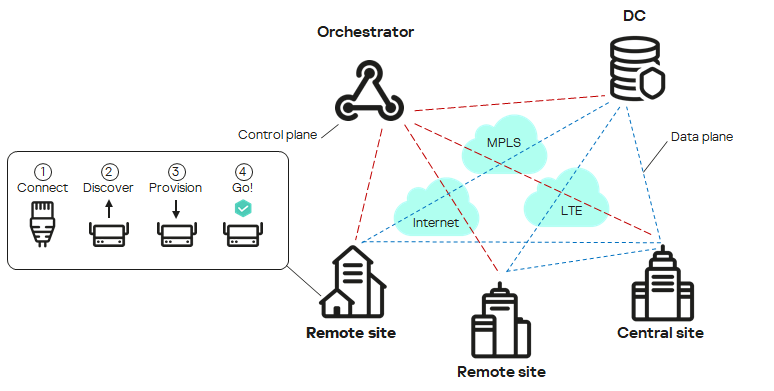About Kaspersky SD-WAN
Kaspersky SD-WAN is used to build Software-Defined Wide Area Networks (Software Defined WAN; SD-WAN). In such networks, routes with the lowest latency and the greatest bandwidth are determined automatically. Traffic is routed using the SDN (Software Defined Networking) technology.
The SDN technology separates the control plane from the data plane and allows managing the network infrastructure using an orchestrator and the API. Separating the control plane from the data plane makes it possible to virtualize network functions (Network Function Virtualization; NFV), wherein network functions such as firewalls, routers, and load balancers are deployed on standard equipment. Network function virtualization in the solution is compliant with the NFV MANO specification (NFV Management and Network Orchestration) standards of the European Telecommunications Standards Institute (ETSI).
Building an SD-WAN network does not depend on transport technologies. You can also send traffic over multiple tunnels based on application requirements regarding bandwidth and quality of service. The following underlay network links are supported:
- MPLS transport networks
- Broadband links for connecting to the Internet
- Leased communication lines
- Wireless connections including 3G, 4G, and LTE
- Satellite links
The solution is intended for service providers and organizations with a large branch network; it replaces standard routers in distributed networks with Customer Premise Equipment devices (hereinafter referred to as CPE devices, CPEs, devices).
Kaspersky SD-WAN lets you do the following:
- Intelligent traffic management
- Automatic CPE device configuration
- Central management of solution components using the web interface
- Network monitoring
- Automatically responding to changes in QoS policies to meet requirements of applications
The figure below shows a diagram of an SD-WAN network built using the Kaspersky SD-WAN solution.

SD-WAN network diagram
